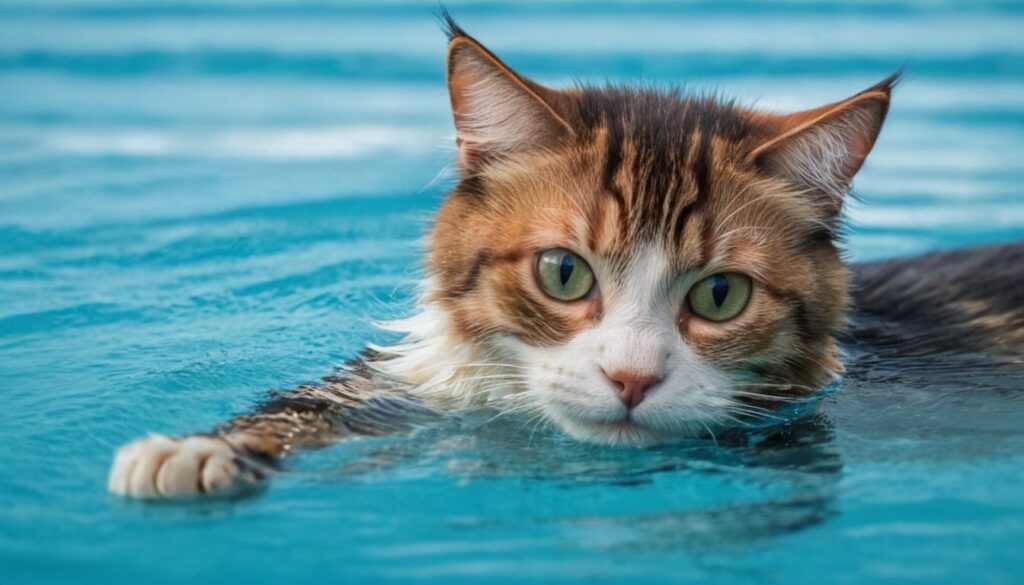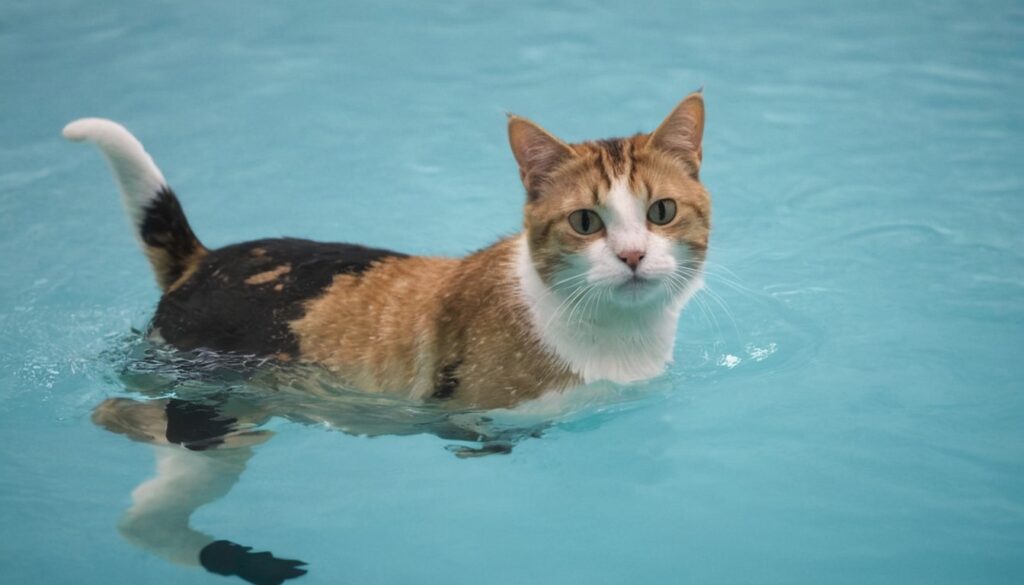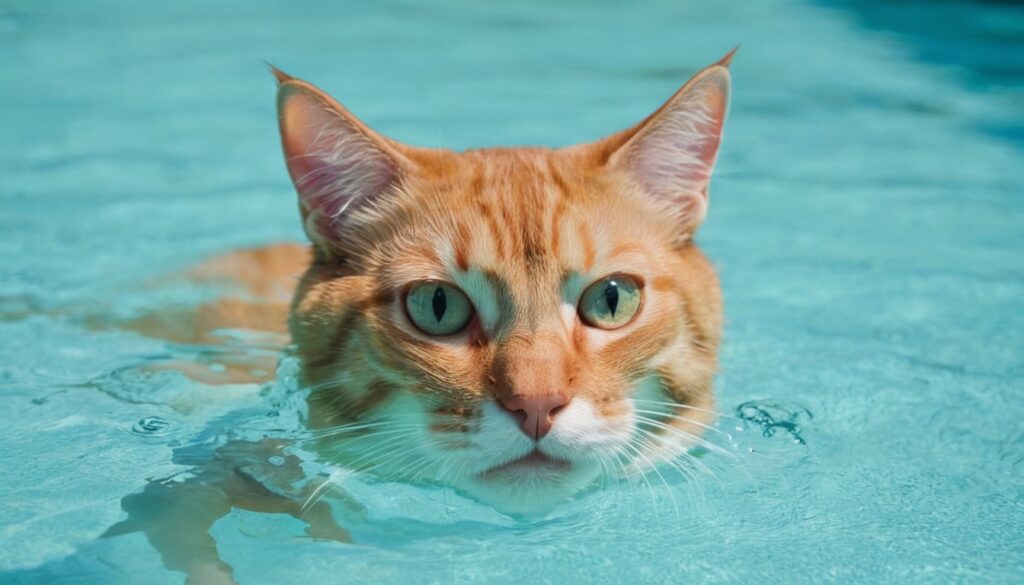Have you ever wondered if cats are like fish in the water or if they prefer to stay on dry land?
Well, just like a fish out of water, the question of whether cats can swim or not remains a mystery to many. But fear not, for in this discussion, we will explore the depths of this feline phenomenon and unravel the truth behind their aquatic abilities.
So, hold your breath and prepare to embark on a journey that will leave you with a newfound understanding of our water-loving companions.
Understanding a Cat’s Natural Instincts

Understanding a cat’s natural instincts can provide valuable insights into their behavior and needs. Cats are predators by nature, and their instincts reflect this. One of their primary instincts is hunting. Cats have a strong desire to chase and catch prey, which is why they often exhibit behaviors such as pouncing, stalking, and playing with toys. This instinct is deeply ingrained in their DNA and can’t be suppressed.
Another important instinct for cats is territoriality. Cats are very territorial creatures and have a strong need to mark their territory. They do this by rubbing their scent glands against objects and scratching surfaces. This behavior helps them establish boundaries and communicate with other cats in the area. Understanding this instinct can help you create a suitable environment for your cat, such as providing scratching posts and designated areas for them to mark.
Lastly, cats have a natural instinct for self-grooming. They spend a significant amount of time cleaning themselves, which serves multiple purposes. It helps them maintain their fur’s cleanliness, remove parasites, and distribute their natural oils. It’s crucial to allow cats to engage in this behavior, as it’s essential for their physical and mental well-being.
The Anatomy That Influences Swimming Ability
Cats’ anatomy plays a crucial role in determining their swimming ability. While cats are known for their agility and grace, their anatomy isn’t specifically designed for swimming. Here are some key factors that influence a cat’s swimming ability:
- Body Structure: Cats have a compact body structure with relatively short legs. This makes it challenging for them to paddle effectively in water.
- Lack of Buoyancy: Unlike aquatic animals, cats don’t have a natural buoyancy that helps them stay afloat. Their bodies are denser, which makes it harder for them to swim.
- Water-Repellent Coat: Cats have a dense and water-repellent coat that helps keep them dry. While this is beneficial on land, it can make it difficult for them to move efficiently in water.
Despite these limitations, some cats are capable of swimming short distances or doggy-paddling to stay afloat. However, it’s important to note that not all cats enjoy being in water and may become stressed or anxious when forced to swim.
Understanding a cat’s anatomy can help us appreciate their natural abilities and limitations when it comes to swimming. It’s important to respect their preferences and ensure their safety when introducing them to water.
Myth or Reality: Cats and Water
Have you ever wondered why cats seem to dislike water so much?
Contrary to popular belief, cats aren’t inherently afraid of water. In fact, many cats possess adaptations that allow them to swim and navigate through water with ease.
Let’s debunk the myth of feline hydrophobia and explore the fascinating relationship between cats and water.
Cats’ Natural Aversion
Despite popular belief, cats aren’t inherently averse to water. While many cats may display a dislike for getting wet, it isn’t a universal trait among all felines. In fact, there are several factors that can influence a cat’s attitude towards water:
- Upbringing: A cat’s early experiences with water can shape their future reactions. If a kitten is exposed to water in a positive and gradual manner, they may be more inclined to tolerate or even enjoy it.
- Breed: Some cat breeds, such as the Maine Coon and the Turkish Van, have a natural affinity for water and are known to swim.
- Individual Personality: Just like humans, cats have unique personalities. Some cats may simply be more adventurous and curious, while others may be more cautious and prefer to stay dry.
Myth of Feline Hydrophobia
Feline hydrophobia, the belief that cats are universally averse to water, is a common myth that doesn’t hold true for all felines. While it’s true that many cats may prefer to avoid water, there are numerous exceptions to this generalization.
Some cats actually enjoy water and may even swim willingly. For example, the Turkish Van breed is known for its affinity for water and has been nicknamed the ‘swimming cat.’ Additionally, certain domestic cats may show interest in water and may be curious enough to explore it.
It’s important to remember that each cat is an individual with its own preferences and behaviors. So, while some cats may dislike water, it’s inaccurate to assume that all cats have a universal aversion to it.
Cats and Water Adaptations

Cats’ ability to adapt to water is a topic that sparks debate among pet owners and researchers alike. Some believe that cats are naturally averse to water, while others argue that they’ve certain adaptations that allow them to navigate aquatic environments. So, what’s the truth? Let’s explore the facts:
- Water-resistant fur: Cats have a thick coat that repels water, keeping their skin dry and insulated.
- Flexible bodies: Their agile and flexible bodies allow them to navigate through water with ease.
- Natural swimming instincts: While not all cats may enjoy swimming, some breeds, like the Maine Coon, have a natural affinity for water and are good swimmers.
While cats may not be as fond of water as dogs, they do possess certain adaptations that enable them to handle aquatic environments. So, the myth of feline hydrophobia may not hold true for all cats.
Signs Your Cat Might Enjoy Swimming
If your cat is frequently found near bodies of water or exhibits a natural curiosity towards water, there’s a good chance they might enjoy swimming. Cats are known for their aversion to water, but some cats actually enjoy taking a dip. Here are some signs that your cat might enjoy swimming.
Firstly, if your cat willingly enters the water without any signs of distress or fear, it’s a clear indication that they find swimming enjoyable. They may even show excitement by playfully splashing around or diving underwater. Additionally, if your cat enjoys playing with water, such as pawing at a dripping faucet or chasing water droplets, they may be more inclined to enjoy swimming.
Another sign is if your cat has a natural buoyancy in water. Cats that have a higher percentage of body fat tend to float more easily, making swimming a more enjoyable experience for them. You may notice that your cat effortlessly glides through the water, demonstrating their comfort and enjoyment.
Furthermore, if your cat is agile and has good coordination, they may be more likely to enjoy swimming. Cats with these traits often find swimming to be a stimulating and fun activity, allowing them to exhibit their athletic abilities in a different environment.
While not all cats enjoy swimming, these signs can help you determine whether your feline friend might be one of the exceptions. If your cat exhibits these behaviors, it could be worth introducing them to a safe and controlled swimming environment to see if they take to it.
Teaching a Cat to Swim: Is It Possible?
After observing these signs that indicate whether your cat might enjoy swimming, it’s natural to wonder if it’s possible to teach a cat to swim. While some cats may naturally take to water, others may require some training and patience.
Here are a few things to consider when teaching your cat to swim:
- Start with shallow water: Begin by introducing your cat to water in a controlled and safe environment, such as a shallow pool or bathtub. This will help them get accustomed to the sensation of being in water.
- Use positive reinforcement: Offer treats and praise to encourage your cat to approach and interact with the water. Make the experience enjoyable for them by providing a calm and reassuring environment.
- Gradual progression: Take small steps and gradually increase the depth of the water. Allow your cat to explore at their own pace, ensuring they feel comfortable and safe throughout the process.
Safety Precautions for Water-loving Cats

To ensure the safety of water-loving cats, it’s important to take certain precautions.
First and foremost, never leave your cat unattended near bodies of water. Even if your cat is a strong swimmer, accidents can happen, and it’s always better to be safe than sorry.
If you have a pool or a pond in your yard, make sure it’s securely fenced off to prevent your cat from accidentally falling in.
Additionally, consider investing in a life jacket specifically designed for cats if you plan on taking them boating or near bodies of water. These life jackets provide extra buoyancy and ensure that your cat stays afloat in case they get tired or disoriented.
When introducing your cat to water, start off slowly and gradually increase their exposure. Use positive reinforcement and treats to make the experience enjoyable for them.
Lastly, always rinse your cat with fresh water after they’ve been in a chlorinated pool or saltwater, as these chemicals can irritate their skin and eyes.
Alternative Water Activities for Cats
Cats can enjoy a variety of alternative water activities to satisfy their curiosity and keep them entertained. While swimming mightn’t be their cup of tea, there are other ways for our feline friends to have fun in the water.
Here are some alternative water activities that cats can enjoy:
- Water play: Cats are known for their playful nature, and water play can be a great way to engage them. Fill up a shallow basin or a small pool with water and let your cat explore. They might enjoy batting at floating toys or chasing the water droplets.
- Water fountain: Cats are naturally attracted to running water, and a water fountain can provide them with endless entertainment. The flowing water will catch their attention and encourage them to drink more, promoting hydration.
- Water puzzles: There are interactive toys available that require cats to use their paws to manipulate water to get treats. These puzzles not only provide mental stimulation but also give cats a chance to experiment with water in a controlled environment.
Frequently Asked Questions
Some common misconceptions about cats and their ability to swim include the belief that all cats hate water or that they will automatically drown. However, many cats can swim and may even enjoy it.
Certain breeds of cats, like the Maine Coon and the Turkish Van, are known to be better swimmers. They have traits that make them more comfortable in water, such as water-resistant coats and a natural affinity for swimming.
You can tell if your cat enjoys being in water by observing their behavior. Look for signs of relaxation or playfulness, like splashing or voluntarily entering the water. Remember, not all cats will enjoy it.
Swimming can be beneficial for your cat’s physical health. It provides low-impact exercise, helps with weight management, and can improve muscle tone. However, always ensure your cat enjoys being in water before attempting swimming.
If you don’t think cats can swim, there are still plenty of alternative water activities they might enjoy. For example, they might like playing with a dripping faucet or chasing ice cubes in a bowl.
Conclusion
In conclusion, while some cats may have a natural instinct for swimming, not all cats enjoy or excel at this activity. It’s important to understand your cat’s individual preferences and comfort levels when it comes to water.
If your cat does enjoy swimming, make sure to take necessary safety precautions and provide alternative water activities to keep them entertained and happy.
Ultimately, every cat is unique and it’s up to their owner to determine what water activities are best suited for them.

